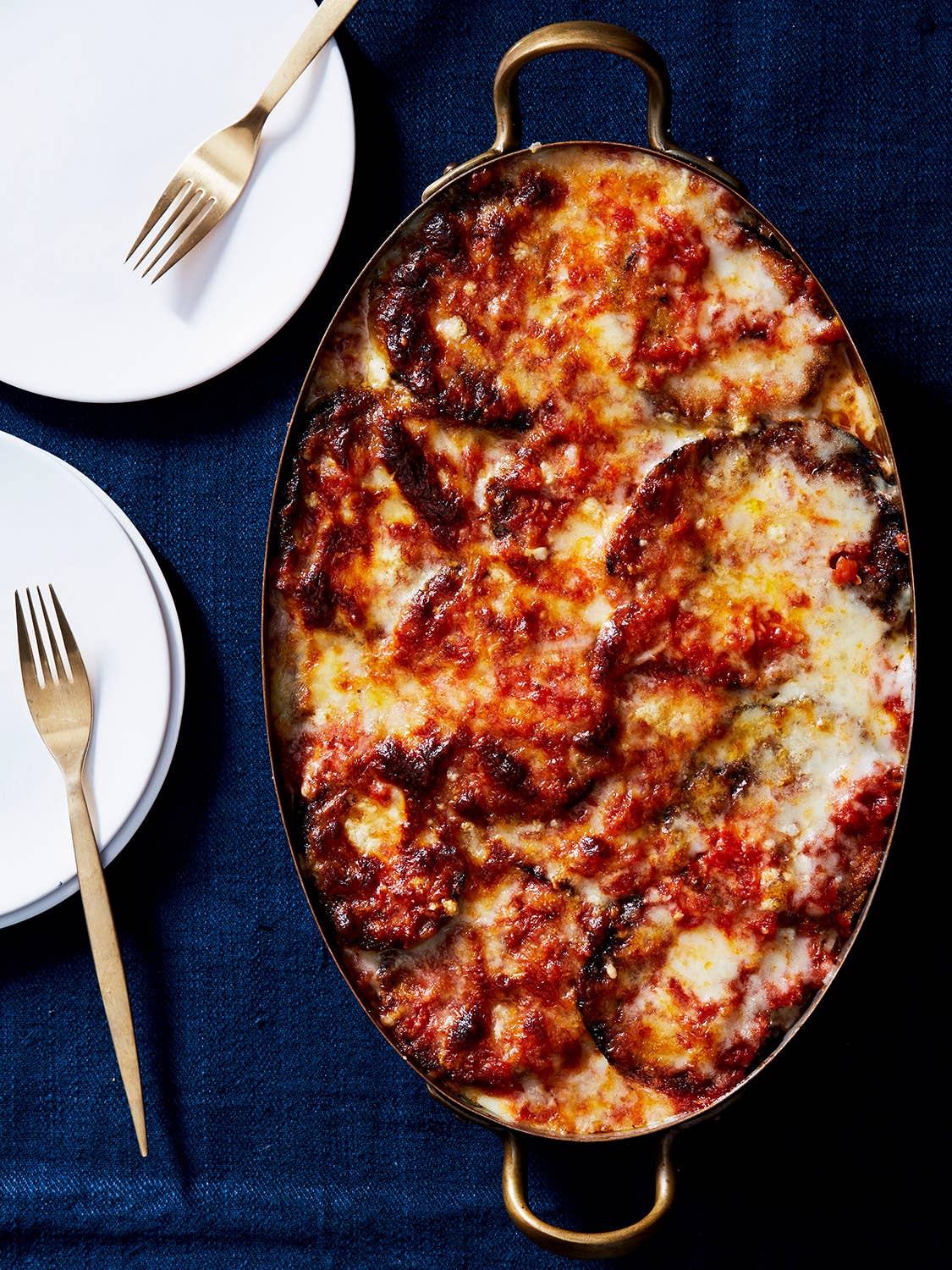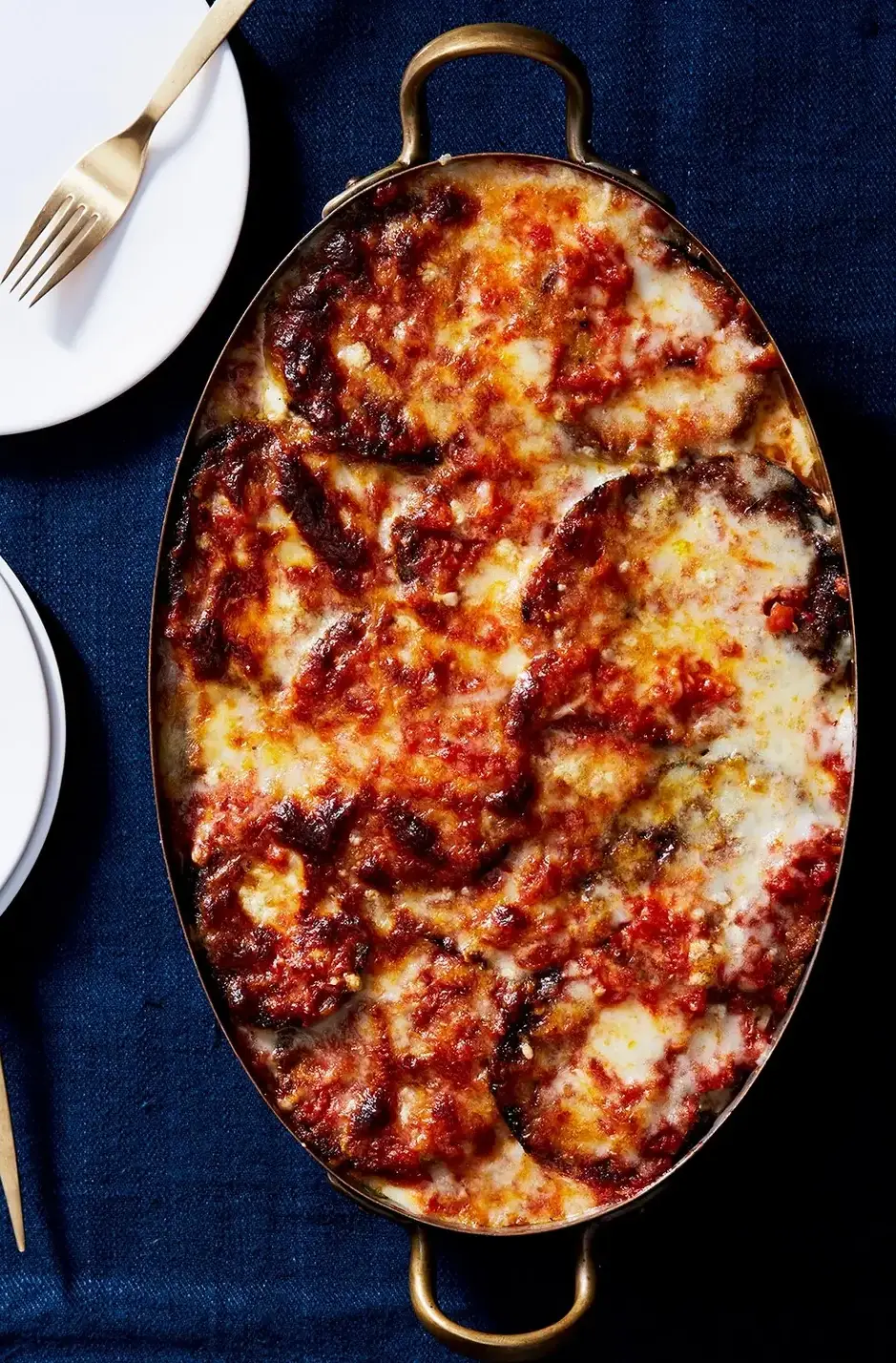The Best-Ever Eggplant Parmigiana
An unadulterated recipe taught to us by an Italian grandma herself
- Serves
serves 8 to 12
- Time
3 hours

For about the first 30 years of my life, barely a week went by without my grandma baking a bubbling, beautiful tray of eggplant parmigiana. A comforting staple of southern Italian kitchens, the dish has also long had an appealing affordability—traditionally most Italians simply used eggplants and tomatoes grown in their own garden—and practicality, as a tray could often feed even a large family through a few meals. It’s adaptable, too: More than just the main course it’s often served as in American culture, eggplant parmigiana could then and can now be eaten in a number of ways—as a primo or first course preceding a meat or seafood dish, as a contorno or vegetable side, or even as an antipasto served at room temperature and cut into squares.
Likely originating from Campania, and more specifically Naples—positioned in the ankle of Italy’s so-called “boot”—this iconic dish mainly falls back on a trifecta of simple ingredients: pan-fried eggplant, red sauce, and cheese. But from there, regions, cooks, and generations have put their own spin on the specialty. Some cooks batter the eggplant in flour or a mixture of egg and bread crumbs, others fry the slices plain. In parts of Calabria, I’ve eaten it with slices of hard-boiled eggs and thin pieces of prosciutto strewn through the layers. Many add fresh basil to the sauce or between the layers of eggplant. And I’ve seen a number of cheeses used, from mozzarella (a given) to provolone, grated Parmigiano or Pecorino Romano, or even ricotta—which would have been utter sacrilege in my family. In Campania and Sicily, you’ll even see dishes by the name of parmigiana made with thinly sliced zucchini or even artichokes instead of eggplant. Of course, today in the U.S. you’ll see the idea used on everything from chicken parmigiana to veal, shrimp, sausage, and meatballs.
What's most critical about this casserole-style Italian dinner is the layering, the characteristic for which many believe parmigiana got its name. Despite theories that it was named for Parmigiano cheese (which is produced far away in the north of Italy) or the city of Parma (same issue), many believe that the dish was named for the word palmigiana, a Sicilian term for the old roof shutters or shingles which the layers of overlapping eggplant resemble.
In and around those layers are the key to eggplant parmigiana’s texture and flavor. Here’s how to get it right.
Slice the Eggplant Thinly
Eggplant naysayers will usually complain about its unique texture, which can feel at times like a cross between a meat and a vegetable. Fans love that about eggplant, how it rides the line between light and hearty. To get the consistency right when layering—that is, to make sure eggplant parm is easily cuttable and neither soggy nor overly raw—cut the slices thinly and evenly with care. Peel most of the eggplant’s skin (a few strips are okay), and use a very sharp knife to slice. Each piece should be no more than ¼ inch thick, and ideally a little thinner than that. If you end up with any particularly thick pieces, slice them in half again or consider omitting them.
Pre-Season Your Dredge
Setting up a dredging station for battering and frying eggplant will save you time and help stave off a kitchen mess. But be sure to season each part of the dredge independently for the greatest overall flavor. My grandma’s recipe used a light coating of bread crumbs and some beaten eggs, so I season each of these components generously with salt before coating and frying. This rule about seasoning ingredients independently applies to each element of eggplant parmigiana—you should also season the tomato sauce well before layering the dish to bake.
Don’t Oversauce, or Overcheese
The one thing I’d hear over and over in my grandma’s kitchen when making parmigiana with her was: “Not too much!” Because there are so many layers to the dish, restraint when adding sauce and cheese will yield a better, more eggplant-forward parm, and a less soggy and gooey one. Spoon and spread just enough sauce onto each layer to lightly cover it, and use a light hand with cheese, sprinkling—never blanketing—the shredded mozzarella between layers. The place to add the most cheese is at the top, where it will melt under the oven’s heat to form a beautiful, bronzed covering.
Work in Stages
A family-sized portion of eggplant parmigiana can take about three hours from start to finish, and it’s most easily done with a partner who can cook the sauce or batter more eggplant slices while you’re pan-frying. But, as you can easily break up the steps into phases, thinking ahead to do so can help keep this dish easy and weeknight-friendly. You can cook the sauce up to a few days ahead, and fry the eggplant slices up to a few hours or even a day before. You can fully assemble eggplant parm, cover the baking dish with plastic wrap, and refrigerate up to a day before baking and serving. If you do chill eggplant parmigiana before baking, add a few minutes to the bake time to be sure it’s fully heated through and the cheese is melted.
Recipe

Ingredients
For the sauce:
- 2 (28-oz.) cans plum tomatoes with their juices
- 3 Tbsp. extra-virgin olive oil
- 6 large garlic cloves, peeled
- Kosher salt
- Freshly ground black pepper
For the eggplant:
- 3 large eggs
- Kosher salt
- 1¼ cups dried plain fine bread crumbs
- 1 Tbsp. dried Italian seasoning, or equal parts dried basil, dried rosemary, and dried oregano
- 3 medium eggplants (about 3 lb. total), mostly peeled except for a few strips of skin, sliced into thin rounds slightly thinner than ¼ in.
- About 1 cup extra-virgin olive oil
- 1½ cups (about 10½ oz.) shredded mozzarella cheese (not fresh)
- 3 Tbsp. finely grated Pecorino Romano
Instructions
Step 1
Step 2
Step 3
Step 4
Step 5
Step 6
- Make the sauce: In a blender, pulse the tomatoes and their juices until just slightly chunky. In a medium–large (4-quart or so) heavy-bottomed pot over medium-low heat, add the oil and garlic, and cook, stirring occasionally, until the garlic is softened slightly and fragrant but not yet browned, about 4 minutes. Pour in the puréed tomato mixture and season with a generous pinch each of salt and pepper. Bring to a gentle simmer and cook, stirring frequently, until thickened slightly, at least 1 to 1½ hours. The sauce can be cooled and refrigerated for up to 2 days.
- If you’re baking and serving right away, set a rack in the top third of the oven and preheat to 400°F. If not, skip the preheat for now.
- Bread the eggplant: In a medium baking dish or wide shallow bowl, beat the eggs with 1 tablespoon water. Season with a generous pinch of salt. In a second baking dish or bowl, stir together the bread crumbs, Italian seasoning, and 1⁄2 teaspoon salt. Working with one or two at a time, dredge the eggplant slices in the egg wash and let the excess drip back into the bowl. Transfer to the bread crumbs and coat very lightly on each side.
- Line a large baking sheet with a few layers of paper towels and set by the stove. In a large high-sided skillet over medium-high heat, heat ½ cup oil until shimmering. Turn the heat down to medium and add some eggplant slices in a single layer until the skillet is full. Cook, turning once, until well browned on each side, about 6 minutes total. Transfer to the prepared baking sheet. Repeat with the remaining eggplant, working in batches as needed and adding a little more oil every other batch, or as needed. As you work, continue to add layers of paper towels between the eggplant slices so they remain separate. The fried eggplant can be refrigerated in airtight container for up to 1 day.
- In a 9-by-13-inch baking dish, ladle ½ cup plus 2 tablespoons sauce into the bottom. Cover the sauce with a single layer of eggplant (start with the thickest ones on the bottom and save the prettiest slices for the top). Ladle another ½ cup sauce on top, spreading it evenly. Sprinkle with about 1⁄3 cup plus 2 tablespoons mozzarella and 1 tablespoon Pecorino. Add another layer of eggplant and repeat this process until you’ve reached the final layer of eggplant. Top this layer only with ½ cup sauce, a final thin layer of mozzarella, and some Pecorino. (Reserve any remaining sauce for another use.) At this point, the eggplant parmigiana can be refrigerated, covered, for up to 1 day.
- Bake, uncovered, until the cheese is melted and bronzed in places and the sauce is bubbling around the edges, about 20 minutes (add about 10 minutes if your dish was previously assembled and chilled). Remove and let cool slightly. Slice into squares and serve warm.
Keep Reading
Continue to Next Story










